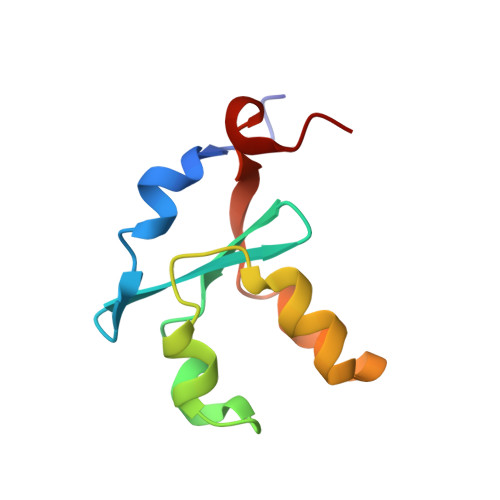Probing the differences between rat liver outer mitochondrial membrane cytochrome b5 and microsomal cytochromes b5.
Altuve, A., Silchenko, S., Lee, K.H., Kuczera, K., Terzyan, S., Zhang, X., Benson, D.R., Rivera, M.(2001) Biochemistry 40: 9469-9483
- PubMed: 11583146
- DOI: https://doi.org/10.1021/bi010636i
- Primary Citation of Related Structures:
1ICC - PubMed Abstract:
Two distinct forms of cytochrome b5 exist in the rat hepatocyte. One is associated with the membrane of the endoplasmic reticulum (microsomal, or Mc, cyt b5) while the other is associated with the outer membrane of liver mitochondria (OM cyt b5). Rat OM cyt b5, the only OM cyt b5 identified so far, has a significantly more negative reduction potential and is substantially more stable toward chemical and thermal denaturation than Mc cytochromes b5. In addition, hemin is kinetically trapped in rat OM cyt b5 but not in the Mc proteins. As a result, no transfer of hemin from rat OM cyt b5 to apomyoglobin is observed at pH values as low as 5.2, nor can the thermodyamically favored ratio of hemin orientational isomers be achieved under physiologically relevant conditions. These differences are striking given the similarity of the respective protein folds. A combined theoretical and experimental study has been conducted in order to probe the structural basis behind the remarkably different properties of rat OM and Mc cytochromes b5. Molecular dynamics (MD) simulations starting from the crystal structure of bovine Mc cyt b5 revealed a conformational change that exposes several internal residues to the aqueous environment. The new conformation is equivalent to the "cleft-opened" intermediate observed in a previously reported MD simulation of bovine Mc cyt b5 [Storch, E. M., and Daggett, V. (1995) Biochemistry 34, 9682-9693]. The rat OM protein does not adopt a comparable conformation in MD simulations, thus restricting access of water to the protein interior. Subsequent comparisons of the protein sequences and structures suggested that an extended hydrophobic network encompassing the side chains of Ala-18, Ile-32, Leu-36, and Leu-47 might contribute to the inability of rat OM cyt b5 to adopt the cleft-opened conformation and, hence, stabilize its fold relative to the Mc isoforms. A corresponding network is not present in bovine Mc cyt b5 because positions 18, 32, and 47, are occupied by Ser, Leu, and Arg, respectively. To probe the roles played by Ala-18, Ile-32, and Leu-47 in endowing rat OM cyt b5 with its unusual structural properties, we have replaced them with the corresponding residues in bovine Mc cyt b5. Hence, the I32L (single), A18S/L47R (double), and A18S/L47R/I32L (triple) mutants of rat OM cyt b5 were prepared. The stability of these proteins was found to decrease in the following order: WT rat OM > rat OM I32L > rat OM A18S/L47R > rat OM A18S/L47R/I32L > bovine Mc cyt b5. The decrease in stability of the rat OM protein correlates with the extent to which the hydrophobic cluster involving the side chains of residues 18, 32, 36, and 47 has been disrupted. Complete disruption of the hydrophobic network in the triple mutant is confirmed in a 2.0 A resolution crystal structure of the protein. Disruption of the hydrophobic network also facilitates hemin loss at pH 5.2 for the double and triple mutants, with the less stable triple mutant exhibiting the greater rate of hemin transfer to apomyoglobin. Finally, 1H NMR spectroscopy and side-by-side comparisons of the crystal structures of bovine Mc, rat OM, and rat OM A18S/L47R/I32L cyt b5 allowed us to conclude that the nature of residue 32 plays a key role in controlling the relative stability of hemin orientational isomers A and B in rat OM cyt b5. A similar analysis led to the conclusion that Leu-70 and Ser-71 play a pivotal role in stabilizing isomer A relative to isomer B in Mc cytochromes b5.
Organizational Affiliation:
Department of Chemistry, Oklahoma State University, Stillwater 74078-3071, USA.
















